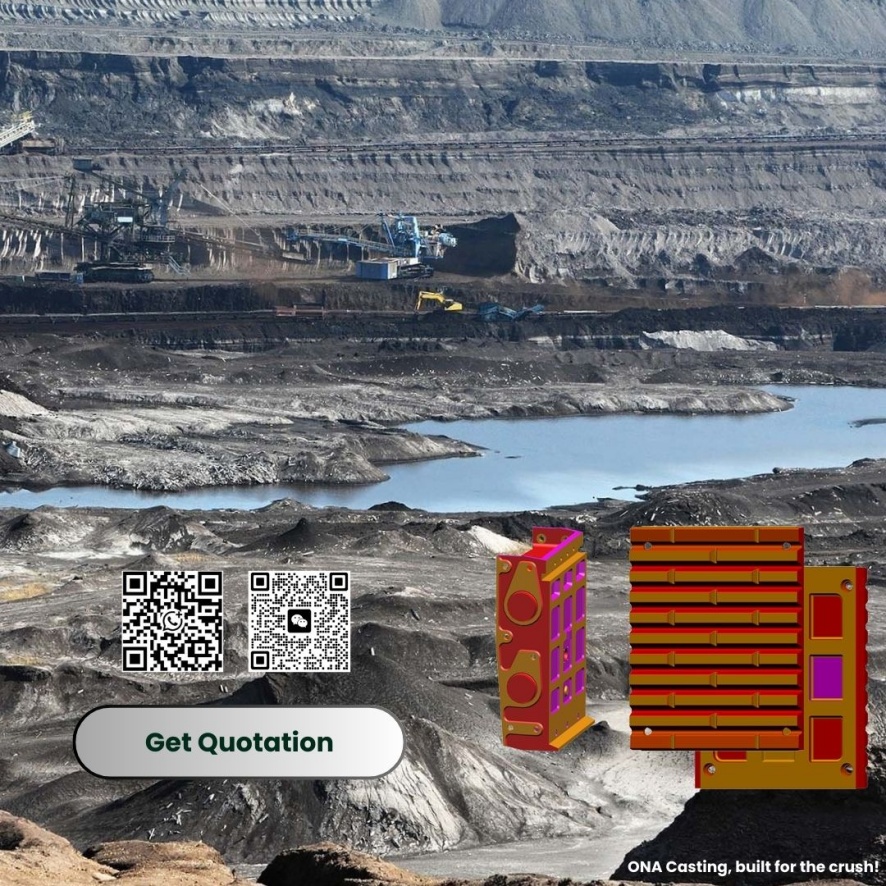Oct 03, 2025
The production process for crusher wear parts (like cone crusher jaw plates, metso cone crusher parts mantles, metso cone liners, hammers, etc.) is a precise and multi-stage operation designed to create parts that are extremely wear-resistant and tough.
Here is a detailed breakdown of the typical production process:
Step 1: Pattern/Mold Making
· Process: A physical model (pattern) of the part is created, typically from wood.
· Purpose: This pattern or mold defines the exact shape and dimensions of the final cast part. Its accuracy is critical.
Step 2: Molding and Casting
1. Mold Creation: Sand molds are commonly used. The pattern is packed in special foundry sand mixed with a binder (like clay or resin) to create a firm mold cavity in the shape of the part. The mold is typically made in two halves (cope and drag).
2. Melting: Raw materials (scrap steel, pig iron, and specific alloys like chromium, molybdenum, and manganese) are melted in a large furnace (e.g., electric arc furnace or induction furnace) at temperatures exceeding 1500°C (2732°F).
3. Pouring: The molten metal is poured into the prepared mold cavity and left to solidify.
Step 3: Shakeout and Cleaning
· Shakeout: Once the casting has cooled and solidified, the sand mold is broken apart, and the raw casting (called a "casting with gates and risers") is removed.
· Cleaning: The casting is then cleaned to remove all residual sand and the excess metal from the pouring channels (gates) and feeders (risers). This is often done using shot blasting (propelling small metal beads at high velocity) or arc air gouging.
Step 4: Heat Treatment
This is a crucial step that determines the final mechanical properties of the part, such as hardness, strength, and toughness.
· Process: The casting is subjected to a carefully controlled sequence of heating and cooling.
· Typical Cycle:
· Quenching: The part is heated to a very high temperature and then rapidly cooled (quenched) in oil or air. This creates a very hard, but brittle, microstructure.
· Tempering: The quenched part is reheated to a lower temperature and held for a specific time before cooling. This reduces brittleness and relieves internal stresses, achieving the perfect balance of hardness and toughness required to withstand impact and abrasion in a crusher.
Step 5: Machining and Finishing
· Process: The heat-treated casting is machined to achieve precise final dimensions and tolerances. This is typically done on CNC (Computer Numerical Control) machines like lathes, milling machines, and drills.
· Purpose: To ensure the part fits perfectly into the crusher. Key contact surfaces, bolt holes, and mating features are machined to exact specifications.
Step 6: Quality Control and Inspection
Quality checks are performed throughout the entire process.
· Chemical Analysis: A sample of the molten metal is analyzed via spectrometry to ensure the alloy composition is correct.
· Dimensional Inspection: Finished parts are measured with calipers, micrometers, and CMMs (Coordinate Measuring Machines) to verify they match the engineering drawings.
· Hardness Testing: The surface hardness is checked at multiple points using a Brinell or Rockwell hardness tester to ensure it meets the required standard.
· Non-Destructive Testing (NDT): Methods like Magnetic Particle Inspection (MPI) or Dye Penetrant Inspection (DPI) are used to detect surface or sub-surface defects like cracks or inclusions that are not visible to the naked eye.
Step 7: Painting and Marking
· The finished part is often painted with a rust-preventative primer for protection during storage and shipping. We can customized color as your needs.
· Important information (part number, heat number, brand) is stamped or painted on the part for identification.
Step 8: Packaging and Shipping
The parts are securely packaged, usually in wooden pallet or iron pallet, to prevent damage during transportation to the customer.
Summary of Key Materials Used:
The specific material chosen depends on the application (e.g., crushing granite vs. recycling concrete).
· High Manganese Steel (Mn14, Mn18, Mn22): The classic material that work-hardens under impact, becoming harder as it is used.
· High Chromium Steel (Cr26): Excellent abrasion resistance but lower impact toughness. Used for highly abrasive conditions with less impact.
· Alloy Steel: A combination of various elements (like Cr, Mo, Ni) to create a balance of properties for specific crushing challenges.
Read More
 Call Us:+86 186 5551 2307
Call Us:+86 186 5551 2307 Mail Us:jhon@onaie.cn
Mail Us:jhon@onaie.cn Call Us:+86 186 5551 2307
Call Us:+86 186 5551 2307 Mail Us:jhon@onaie.cn
Mail Us:jhon@onaie.cn